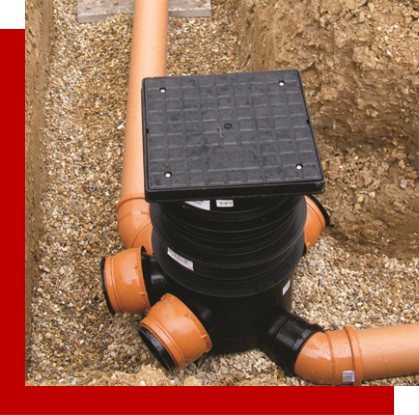Help & Advice
Drains Explained
Drains are underground pipes that take water away from houses and buildings. Most homes have separate drains for rainwater and wastewater. Rainwater drains collect rainwater from roofs, driveways and roads and channel them to nearby rivers and beaches. Wastewater drains, on the other hand, transport waste water from toilets, sinks, baths and showers, dishwashers and washing machines. These types of drains then channel the water to local wastewater treatment sites. Once the water has drained from your property, it enters a rainwater or wastewater sewer which carries the water from the source point to its final destination.The design and size of a drain will take into consideration the volume of water that passes through it. Drain pipes typically have a circular profile and are manufactured using ceramic or plastic.


Drains Manholes
Drain manholes, also known as inspection chambers, serve a number of purposes. They act as collection points for two or more drain pipes coming from different directions. They also provide direct access to drain pipes for maintenance purposes. Usually manufactured of metal or plastic, drain manholes typically comprise of a large circular chamber found on the exterior of your property.
Inspection chambers are usually designed to be large enough to allow a person to climb inside to perform an inspection or repair of the piping system, although this is not always the case. CCTV drain surveys and high pressure water jetting can be carried out via manhole chambers in order to remove blockages.
Domestic Gully
Domestic gully drains act as collection points for waste pipes exiting your property. They connect into the drainage network around your property and take the waste water from sinks, showers and other domestic appliances.
If a domestic gully drain becomes blocked it is usually caused by two common factors. The most common is that they act as a settling tank, allowing all the debris and rubbish around your property to collect at the bottom of the gully to avoid it from flowing down the drain itself. The gully can only hold so much however before it blocks. In this case the sediment and debris needs removing from the blocked gully drain.
The second most common reason is that a foreign object has washed down the gully drain causing it to block. If this is the case we recommend that the drain is professionally unblocked.


Saniflo Systems
A Saniflo macerating toilet system works by breaking toilet paper and human waste into pieces. The system includes a blade that rotates and cuts toilet paper while liquefying feces. The water flushing into the system mixes with the waste and the force of the flush pumps it into the drainage system in the form of a slurry.
Once the effluent reaches a predetermined level, a micro-switch in the macerator’s pressure chamber turns on. The macerator blade turns at 3,600 revolutions per minute, reducing waste into liquid within four seconds. The waste pumps into the drainage system through a 1 inch diameter standard pipe. Once all of the foul pumps out, the micro-switch automatically turns off. Non-return valves in the macerator prevents any backflow of foul from draining back into the system. Once the toilet fills up with water, the system is ready for another use.
Land Drainage
Land drains appear in many different forms such as aco-drains, storm drains, and flexible perforated land drainage pipes which can be purchased in different lengths and sizes. Land drainage can be installed under different circumstances. For example, underneath playing fields to prevent the ground from becoming waterlogged, as an aco-drain to channel land water off driveways, or in the form of a storm-gully to drain standing water off car parks and other large open areas. Land drainage installed under the ground very rarely becomes blocked, but it does need the occasional maintenance to remove debris and sediment. If your land drain becomes blocked give SOS Drainage a call and have the drain unblocked at half the price of national companies.





